Nokia N95 Music Focus
Digital music on the move has been one of the biggest growth areas for consumer electronics in the last decade. The iconic iPod has been at the forefront of this digital audio player charge, but it has become increasingly threatened by the inclusion of music playback in mobile phones. The Nokia Nseries phones are no exception, indeed they have been leading the charge, together with Sony Ericsson's Walkman branded phones and smartphones. Through the XpressMusic branding, Nokia has sought to emphasise the music capabilities of its Nseries portfolio. The N95 continues and adds to this trend. It is a very good digital audio player and, thanks to its smartphone background, boasts features that leave many digital audio players behind. Here we take a closer look at its implementation and explore its capabilities.
N95 Hardware
The N95's dual slide design clearly has multimedia playback in mind. The top slide of the N95 reveals 4 back-lit shortcut keys (from top to bottom: forward, play/pause, stop, backward) which can be used to control both video and music playback. If it is not already running, a press of the play/pause key will start the Music Player application. Otherwise the keys behave as you would expect with fast forward and rewind available via a long press of the backward or forward keys. If the keys are when used outside of Music Player there's an on screen indication showing the key pressed and the current track.


On the right hand side of the N95 there are the volume controls (also the digital zoom controls in the Camera application). On the left hand side of the N95 there's a 3.5mm (composite) audio jack. In the N95 retail box, Nokia supply a headset that comes in two parts. The first part contains the microphone and remote controls (answer/make call, play/pause, forwards and backwards) while the second part is a matching set of headphones. The connection between the remote and headphones is also a 3.5mm (standard) audio jack. This means you can use your own headset either plugged straight into the device or plugged into the remote control/microphone unit. I did notice a faint hiss when using a high end (Ultimate Ears) headset when plugged directly into the N95. It was only really noticeable when listening to Piano music, and it was lessened when using the remote unit. It is not audible on lower quality headsets, including those supplied with the N95, presumably because they lack the range of the Ultimate Ears.
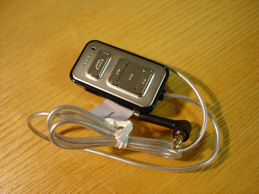
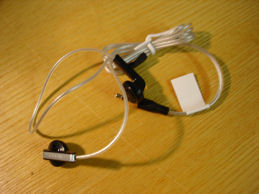
On either side, at the top of the N95, there are stereo speakers. The output from these is obviously limited, but is good enough for desk music when nothing else is available. It is particularly good for the spoken word, such as that found in many podcasts or audio books.
On the left hand side of the device there is a microSD (TransFlash) card slot. This supports cards of up to 2GB in size, a 2GB card should give enough space for around 500 tracks (depending on length, formatting and encoding). The slot also supports hot-swapping (switching cards while the device is on) which means it is practical, if a little fiddly, to have a card dedicated to music usage.
At the bottom of the device, there's a standard mini USB 2.0 port which is used for PC connectivity. The USB connection supports PC Suite (Music Manager), MTP (Music Transfer Protocol as used by Windows Media Player) and Mass Storage (phone appears as an extra drive on the computer).
Internally the N95 has an FM Radio, WiFi connectivity with support for UPnP and Bluetooth with support for the A2DP and AVCRP profiles (for Stereo Music and Remote Control over Bluetooth). We'll have a closer look at the implications of this later in the article.
Music Player Application
The N95 has the most recent version of the Nseries Music Player application, as seen on the Nseries Music Edition devices. The application presents your music library in the typical hierarchical approach (All Songs, Play lists, Artists, Albums, Genres and Composers), through which you can drill down to access the music you want to play. Once the music starts, the Now Playing screen is shown, with the usual music playback controls. These controls are associated with the cursor keys for quick access, for example left and right on the directional controls skip tracks on a single press or fast forwards/rewinds them if held down.

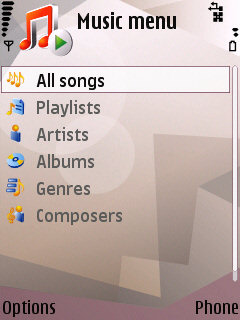
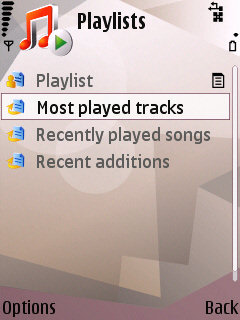
The application includes a variety of features beyond basic playback. Shuffle and repeat modes and Album Art are present as expected, but there's a user programmable equalizer together with a number of presets, visualisations (relatively basic), audio settings (that control stereo widening, loudness and balance) and playlist management. Playlists can be managed on the device, with full editing capabilities, and there are a number of predefined smart playlists too (Recently Played, Recently Added, Most Played).
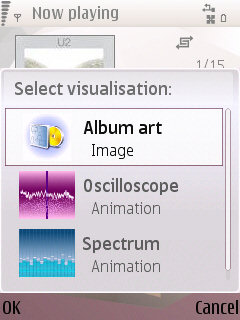

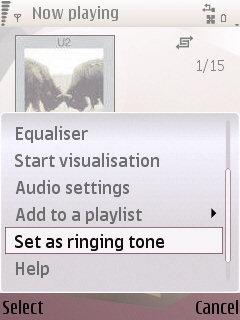
A welcome change from earlier devices is that the Music Player now recognises when new music has been transferred to the phone (for me it worked for Windows Media Player and after downloading podcasts) and will automatically update your music library. Previously this was a manual process and there's still a manual update option in the menu for instances where you want to force an update of the library.
Music Player is also integrated into the Active Idle screen. The current track is shown and clicking on the item will take you back to the Music Player. This, together with the Multimedia shortcut key (on which a long press will start Music Player) and the hardware shortcut keys on the top slide mean music control is never far away.
In terms of formats, Music Player supports MP3, (un-DRMed) AAC, AAC+ and WMA, which should cover most people's collections.
Radio Application
The N95 has the standard Nseries/Nokia S60 radio player which includes support for Visual Radio. Visual Radio is a little used standard that aims to deliver extra information to listeners over the air. When it's available it can be a useful extra service, but unfortunately it is not very widespread. Details of the stations using Visual Radio can be found here. For the radio to work, you must plug in a headset or the remote control, sound can then be channelled through the phone's loudspeakers, but unfortunately can not be channelled to a Bluetooth headset. Radio may seem a bit old-school these days, but is still very popular. It is a nice extra for where you get bored with your onboard music or want to listen to the latest headlines.
Outside of traditional FM radio, the N95 also has support for Real Audio streams, thanks to the inclusion of Real Player. There are a great number of radio stations that make Real Audio streams available, there is a comprehensive list for UK stations available here. Once loaded in RealPlayer, stations can be saved as streaming links and stored in the Gallery application.
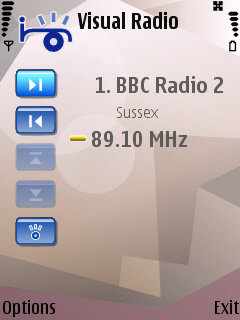
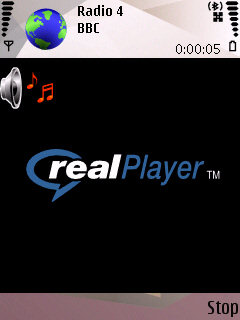
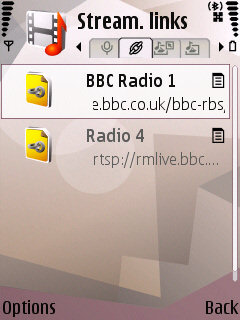
Getting Music to the N95
As hinted at earlier, there are a number of ways to copy music to the N95. One option is to use Windows Media Player 11. When you connect the USB cable to the N95, you are asked to choose the connection mode (e.g. 'Media Player'). The N95 is automatically recognised by Windows Media Player and music can be dragged from your music library onto an icon representing your device. Once you decide which music to copy, a single press of the sync button starts the process. Thanks to the USB 2.0 connection, sync speeds are reasonable. There are some advanced features too, such as the ability to transcode formats and bitrates to optimise file size or to make the entire process automatic with a random collection of songs from your library copied to the N95 at each sync. Windows Media Player can be used to rip CDs and manage the PC side of the music collection.
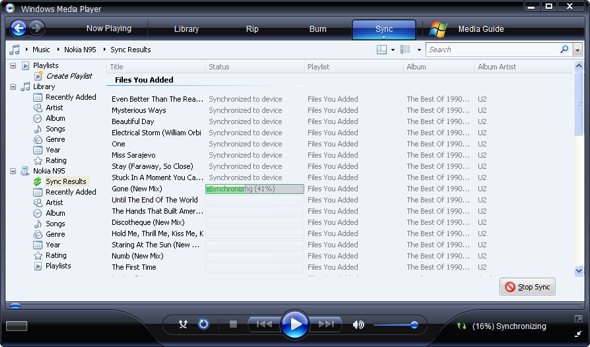
The N95 supports WMA files protected by the Play4Sure DRM, but these must be coped using Windows Media Player in order to ensure that the appropriate license files are also copied across. Play4Sure DRM is used by a number of music subscription services which allow unlimited downloads and playback of music provided you continue your subscription. For example, Napster to Go in the UK charges £14.99 for their unlimited service, which gives access to some 3 million or so tracks. If you're the sort of person who buys a couple of CDs a month this service will be well worth investigating as it could save you money in the long run. Yahoo Music Unlimited is a similar service which is available in the US with a price point of $14.99. Neither of these services yet list the N95 as a compatible device, but in my tests Naspter to Go certainly worked without any problems, and there's a free trial available for both services.
For those who do not wish to use Windows Media Player, Nokia provide Music Manager as part of PC Suite. It is also a sensible choice for those who are not already using their PC for digital music as it is easy to get to grips with and is better at ripping CDs into a format that is optimal for the N95 (AAC+). Music Manager works in a similar way to PC Suite, with the ability to drag and drop files from your PC to the N95. It too has a random transfer feature and allows you to set a maximum space to be used by music files.

If neither Windows Media Player nor Nokia Music Manager appeal to you then you can copy music files across manually. You can either do this using the File Manager portion of PC Suite or use the USB Mass Storage mode of the USB connection. In this mode the phone will appear as a disk drive and this should enable you to use it with a number of other Music Management tools, including WinAmp, Music Match and, with third party plug-ins, iTunes. If you are on a Mac you can use the Nokia Music Manager for Mac; this is intended for use with the N91 but it should work just as well with the N95. Finally, it is also possible to copy music to the N95 using UPnP (which I discuss below).
UPnP
The N95 has support for the UPnP protocol. UPnP is aimed at making it easy for devices to interact over a network, be it wired or wireless. On the N95, UPnP shares content stored on the phone with other UPnP devices (acting as a server) and can access content on other UPnP devices (acting as a client); the connection to other devices is made via WiFi.
On the N95, the UPnP functionality is set up through the Home Network application. Here you specify the wireless network to connect to and what content to share from the N95. In order for the N95 to share content (act as a server) you must explicitly turn sharing on. For accessing other UPnP devices (acting as a client) you use Gallery. On the CD that ships with the N95 is a program called Simple Center. Simple Center is a UPnP server/client for Windows PCs and will scan your PC for music and video files and make these available.
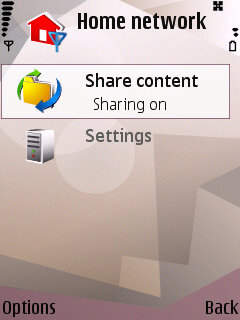
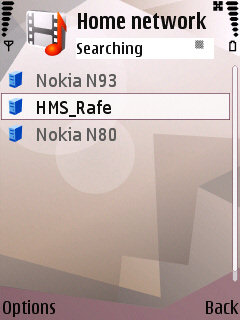
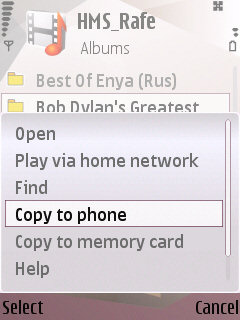
One you have set up UPnP on the N95, a Home Network section will appear in Gallery and from here you can browse other UPnP devices (including your PC, if you have installed Simple Center). Gallery will automatically search for, and list, other UPnP devices on your network. The devices can be browsed (in a similar way to a filing system) and you can choose to ‘copy to your device’ (thus giving you yet another way to get music to your device) or ‘show via home network’ (allowing playback or showing of content on other UPnP devices). If you have a friend with another UPnP enabled Nseries device (N80, N93, N93i) you can also share content from your phones back and forth using this functionality.
With Simple Center installed on your PC, it is possible to copy or sync content between the N95 and the PC in both directions. You can also use your N95 in a remote control like fashion to play music on your PC that is also stored on the PC thanks to the ‘show via home network’ functionality (illustrated below).
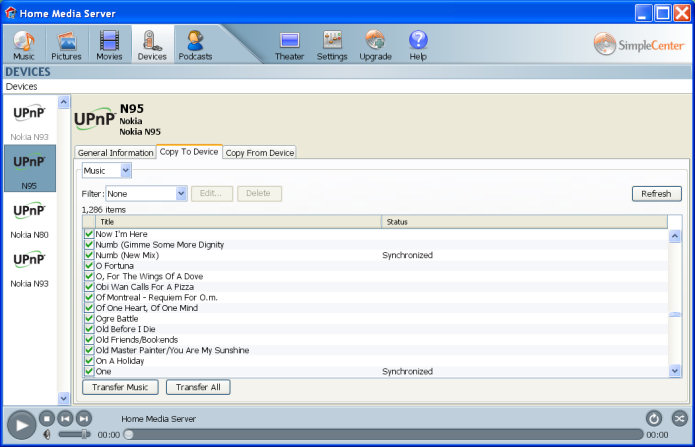
UPnP really comes into its own when there are other UPnP devices in the home. There are a number of UPnP media streamer devices on the market from the likes of Netgear, D-Link and Phillips. These are generally attached to a television or a stereo and act as client devices, playing back content from UPnP servers (usually on a PC) on their respective hosts. In the case of the N95 you can use a media streamer to access content stored on the N95 (such as your music library). However, more useful is using the N95 as an UPnP remote control, browsing content from a UPnP server (e.g. one running on your computer) and playing it back over another UPnP device (e.g. a media streamer). One real world example of this would be sitting on your sofa using your N95 to control the playback of music that is stored on your PC on your UPnP enabled home stereo.
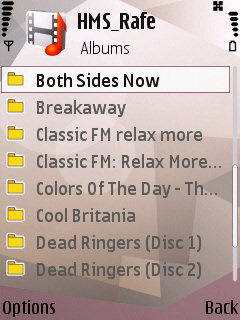
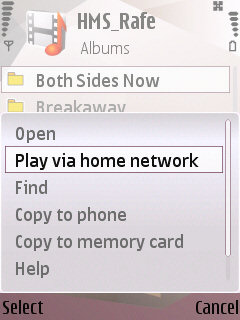
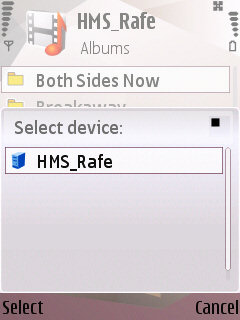
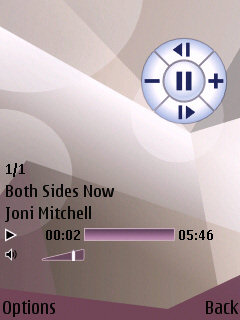
Selecting an album on a remote UPnP device and then playing it back on the remote device all controlled from the N95.
I’ve focussed on the music aspects here, but the same applies for pictures and videos. You can, for example, use UPnP to show a video that is stored on your N95 on your PC (via Simple Center) or on your TV (via a media streamer). Similarly you can use the N95 to control a slideshow of images.
The problem with UPnP is that it is still a relative young standard and there are a limited number of UPnP devices available. Although they are theoretically all interoperable, this is not always the case (for example, not all devices can play back all music formats). I think the greatest benefits come with using the N95 in conjunction with a media streamer, but even if you just use the N95 and the Simple Center software on your PC there is still a lot on offer. It is impressive stuff and shows the virtues of using open standards.
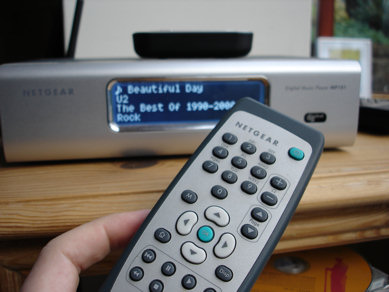
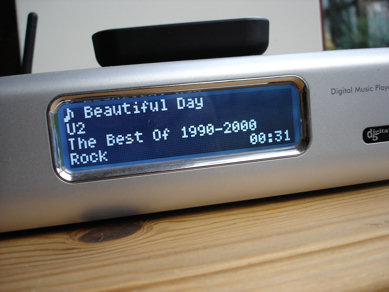
Bluetooth
The N95 supports the A2DP and AVCRP Bluetooth profiles, which allow the playback and control of stereo audio over Bluetooth. At first, doing away with wires might seem like something of a novelty, but it does save hassle and means you can leave your device safely tucked away. I tested the N95 with Nokia’s BH-501 and Sony Ericsson’s HBH-DS970 and both gave excellent quality audio. The DS970 includes full remote control of music playback (AVCRP) and was, for me, more comfortable. The BH-501 was better for making calls because it supported voice dialing.
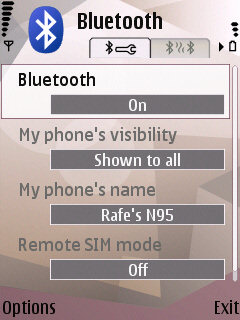
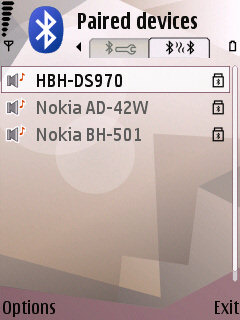
UPnP might be the most feature rich way to wirelessly connect an N95 to a stereo but it is not the only way. For those without a WiFi network or a media streamer, a Bluetooth Audio Gateway such as Nokia’s AD-42W is a good solution. The AD-42W is a small box that you connect to a stereo via a RCA (phono) cable; the Gateway receives a Bluetooth audio stream and sends it in stereo via the RCA cable. The Gateway utilizes the same A2DP profile as stereo headsets to stream the audio and they are paired with the N95 like any other Bluetooth device.


Further A2DP Bluetooth devices are coming out all the time. Parrot has been showing off an A2DP-enabled ‘boom-box’ and I’m sure there is lots more on the way too. All of the Bluetooth accessories mentioned above are an extra purchase, but this is a not an uncommon pattern in the digital music world.
TV Out
The N95 ships with a TV Out cable, which plugs into the same composite 3.5mm port as the headphones. While the obvious use of this is showing pictures and video on the TV, it can also be used to play back music. The TV Out cable will work with most stereos too (the composite video, yellow lead, can be left disconnected). It may not be as elegant as the wireless solutions mentioned above, but it is available out of the box.
Third Party Software
Since the N95 is running on an open software platform, it is of course possible to add additional functionality through the installation of software. For example, there is Nokia’s free Podcasting application (available via the Downloads! application on the N95). This application allows you to subscribe to podcasts (episodic audio shows) and download them to your device. Features include an in-built podcast directory, podcast search and scheduled downloads. Podcast can be downloaded using a cellular connection or WiFi and played back using the Music player application (audio podcasts) or Real Player (video podcasts). Also available from Nokia is the Internet Radio application, which lets you listen to the SHOUTcast audio streams which a number of Internet radio stations broadcast.
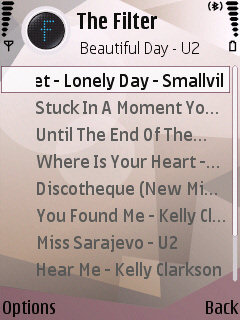
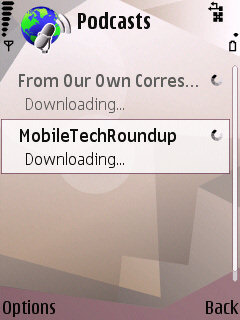
There are an ever growing number of applications from third parties too. These include Audible Player, which lets you download and playback Audible content, such as audio books, on the N95. There is also the MyStrands Social Player which is a Music player replacement, but also adds online services (download album art), music discovery (recommendation based on your tastes) and community features. The Filter, which will automatically create playlists from the contents of your music library and Pocket Ogg, which is a music player supporting the open source .ogg format.
All of these applications mean that you can significantly extend the music and audio related capabilities of the N95 beyond what is available out of the box.
Conclusion
The N95 is an impressive music device. There are five ways to get stereo audio out of the N95 (stereo speakers, headset, Bluetooth, TV-Out, UPnP) and even these can be further broken down (e.g. FM Radio transmitter via the 3.5mm jack anyone? - hey, I'm reviewing one of these next week! - Ed). It is amazing to see this level of versatility in a single device considering that the N70 (the hot Nseries phone this time last year) only had one of these. PC connectivity is good although perhaps, overall, not as cohesive as the iTunes/iPod combination and the lack of an integrated music store is a current omission, though this is likely to change in the near future.
The quality of the sound produced by the N95 is excellent. The clarity and accuracy of the sound is now dictated more by quality of the headset and the encoding of the music file or stream rather than any hardware limitations. Audio buffs will notice the usual problems with digital music, but the average user will have no complaints.
The N95 integrates well with third party services and its capabilities can be extended through third party software. It is theoretically possible for any software-based DRM mechanism to be added to the N95. This reflects an important difference in attitude between digital music market leader Apple and Nokia. Apple prefers a proprietary ‘walled garden’ approach whereas Nokia has chosen to integrate with other products via open standards. Consequently Apple is able to closely control all aspect of the user experience, but locks customers into its own solutions. Nokia’s more open minded approach will appeal to the technical, but may not resonate with the wider public since the user experience can be less cohesive. However, experience in other areas does suggest the open approach does offer better longer term prospects.
When assessing the music functionality, the obvious question is: Is it as good as a standalone player? Here it is worth drawing a distinction between the different types of standalone players. The large hard-disk based players such as the iPod or the Zune are not going to be directly replaced by the N95. However, they are threatened by the convenience of the one device solution. It comes down to the question of which is preferable – having your entire music library available or having to only carry one device. More at risk are the flash memory based players such as the iPod Nano or SanDisk Sansa. Why would you carry one of these devices when the N95 can replicate or better the functionality?
The main ‘problem’ issues with the N95 in this area are memory (realistically you will need to buy a 2GB card – at a cost of about £25-30), battery life (not as good as standalone; also shares battery with a GPS/Wi-Fi/Camera-bearing phone) and cost (more expensive). Each person is going to assess this differently, but for me none of these outweigh the benefits of carrying around one device. In making this calculation it is also necessary to evaluate the wider picture since the N95 is much more than just a music player. At one time I would have added ease of use as a problem in common with most other converged devices, but thanks to the top slide, good software and good PC connectivity there is little to complain about here.
Overall, the N95 scores highly as a music device, offering excellent functionality and a good user experience. There is room for improvement (lack of cohesiveness of the user experience, lack of an integrated music store) and device convergence brings its own problems (shared battery, complexity), but measured against the overall abilities and appeal of the device, these will not trouble many of the N95’s potential buyers.
Rafe Blandford, 30 Mar 2007
Also in this series
Nokia N95 - Part 1, The Navigator (Smart2Go)
Earlier Coverage and Resources
Nokia N95 First Impressions Preview (prototype model)
Nokia N95 Video Review
Nokia N95 - Your Questions Answered (prototype model)
Nokia N95 Forum
Nokia N95 Software Directory / List
Nokia N95 Device Photos
Comment: Hey Rafe and Steve.
I love your site and the reviews.
The review is very well..nice work ;)
Check out my site: symbianworld.de.vu
Comment: Great article Rafe.
Something I would also be interested to hear is bitrate - what can the N95 support and what is the best compromise between quality and storage space? Also, which format do you think is best for audio?
I generally use mp3 as this is what I typically playback on my PC and on other devices so I usually just drop the same mp3s on my phone. Some mp3s I have ripped from cd in very high bitrate however, so usually compress these a bit for mobile - usually 128kbps.
I would also like to know more about the video playback of the N95 and again, bitrate support - what is a decent bitrate for the device and what is too high. Have Nokia done a tech spec which tells you max video and audio bitrates??
A lot of what is detailed in this article also applys to video - connectivity, accessing and playing the content on the phone - but I would love a bit more indepth information on this and perhaps other media players such as SmartMovie. I get my N95 next week and would like to start preparing content for it so would really like to know what it can handle.
Thanks for the article.
Comment: What's the difference between the Stop and Pause buttons? In most MP3 players today, there is only one of the two, no point in having both I think...
Comment: The stop button stops the music and takes you back to the beginning of the track, the pause button stops the music and will then resume it. Yes the stop button is strictly necessary as the same effect can be achieved by pause - backwards... That said it does makes sense for some (i.e. listen to the whole of track etc).
I'll look into the bit rate stuff and get back to you. As I recall the supported bit rates are quite high for audio. Off the top my head officially its 320 ish for mp3 512 ish for aac. In practise it may be higher. Personally I think 128 for MP3 128 or 96 for AAC is ok or 96 or 64 if AAC+. Though the majority of my music is 128 in MP3 or AAC+
We'll be covering video in a separate review, I'll try and take your requests on board. And yes a lot of this article is applicable to video so we wont necessarily go into the same detail (on UPnP for example). But by contrast TV-Out is much more useful for video (and frankly I imagine most people would use this rather than UPnP).
symbianworld.de.vu - nice site and thanks for linking back here :)
Comment: as a music player? 1 hours? 10 hours? It would be a good test if you all could put some music on and just let it run...
Comment: We're talking in the region of 10 hours or more. However its not that simple since it will be different depending on whether you used Bluetooth, speakers, headset etc. Also have visualisation on and the screen on will make it lower.
Music isn't terribly processor intensive so the battery life is good. Its the other stuff (GPS, WiFim 3G) which will run it down more.
Comment: Did you try out PocketOgg on the N95? I never owned a Symbian phone, so I am wondering how good the integration is with PocketOgg. Can you easily make it the default music player?
Also I heard that the video player only supports a limited set of codecs. Are there replacements similar to PocketOgg that you have tried out, especially with the TV out?
Comment: Is there not also a volume up/down on the remote unit? It looks like there are some additional buttons on the side there?
Cheers
Comment: Hi - is the Audio Quality when playing MP3`s better than the Nokia N80 or Nokia N91?
in particular, the volume output.. nice an loud?
my old N80 and SE W810i just werent loud enuff :-(
but then my old N91 had incredible sound through headphones and plenty of volume..
thoughts?
Comment: Thanks Rafe, look forward to you answering more questions on video. Thanks for some info regarding audio bitrate.
As for some of the other questions, there are apps like smartmovie with which you have an expanded set of video formats that you can playback such as divx/xvid.
thecreativelifeblog.com tested the battery life for video which came in at just over 3.5 hours in offline mode and audio playback was over 10 hours. I would have thought that radio would be better still as it would be less intensive on the phone.
Basically the phone should withstand a day of heavy use and 2-3 days of general or easy use.
Comment: Great review - thanks.
I saw somewhere that Sandisk recently announced a 4Gb MicroSD card. Any idea whether the N95 will be able to support it when it becomes widely available?
Comment: Hi. Can you have a review about the Nokia N95's 5 megapixel camera? thanks
Comment: No you can't make PocketOgg the default player. I imagine the developers may look at this in the future. It does work as a solution, but its not ideal. Then again I think .ogg users will probably be OK putting up with this because they tend to be more technically minded.
I though I had mentioned volume controls, but yes they are the button of left hand side.
I honestly have difficult telling the difference between these devices. I think the N91 was very good, but I can't do a direct comparison. The volume issue due to EU regulation is still there, but a good set of headphones can solve this. It's been OK for me (I've been using around 60% volume).
I'm trying to get confirmation of the 4GB cards. they are SDHC cards and although I have seen a report these work there's nothing official yet.
The camera is next on the review list. Should be late Monday / early Tuesday.
Comment: Great write-up! It's really nice to see that when a respectable web site gets a free N95 they really take the time to review it right and share with the community.
Unlike some *cough Darla Mack cough* who get their free phone, throw up a crappy unboxing video and then never mention it again.
I'm happy that not everyone abuses the system. Keep up the great work!
Comment: Nokia's Music Player is a turd compared to the iTunes on the iPhone. No gapless playback, no Cover Flow, no smart folders.
Comment: Sigh, my uPnP works only one way via Home Centre network Simple Centre program....
N95 works as a remote and can access stuff on the laptop but my laptop could not find the N95....
anyone can help
to the above poster, i used the ipod before.... wonderful as it is... it is a dedicated music player.... N95 is a multi-convergence device...does everything effectively...no complaints here, but there are different stuff aimed at different markets
Comment: You can use 3rd party video applications to view divx/xvid video on tv via the line out socket but only in portrait. If you want to view full screen you are advised to convert to high quality mp4 and use real player. This way you can rotate the screen using the unique slider and get true widescreen viewing!

